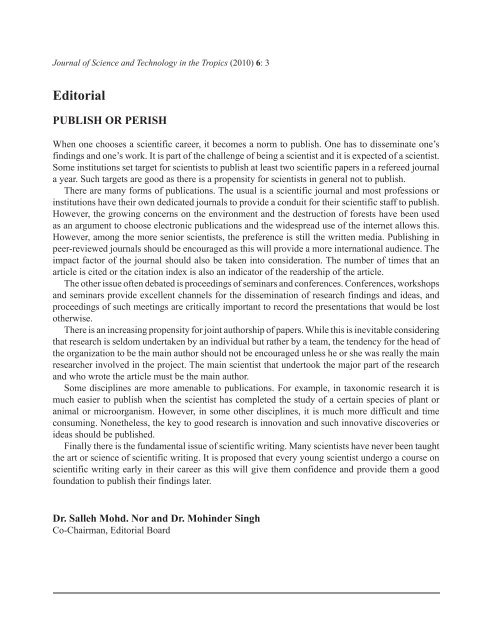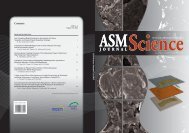Download - Akademi Sains Malaysia
Download - Akademi Sains Malaysia
Download - Akademi Sains Malaysia
Create successful ePaper yourself
Turn your PDF publications into a flip-book with our unique Google optimized e-Paper software.
Journal of Science and Technology in the Tropics (2010) 6: 3<br />
Editorial<br />
PUBLISH OR PERISH<br />
When one chooses a scientific career, it becomes a norm to publish. One has to disseminate one’s<br />
findings and one’s work. It is part of the challenge of being a scientist and it is expected of a scientist.<br />
Some institutions set target for scientists to publish at least two scientific papers in a refereed journal<br />
a year. Such targets are good as there is a propensity for scientists in general not to publish.<br />
There are many forms of publications. The usual is a scientific journal and most professions or<br />
institutions have their own dedicated journals to provide a conduit for their scientific staff to publish.<br />
However, the growing concerns on the environment and the destruction of forests have been used<br />
as an argument to choose electronic publications and the widespread use of the internet allows this.<br />
However, among the more senior scientists, the preference is still the written media. Publishing in<br />
peer-reviewed journals should be encouraged as this will provide a more international audience. The<br />
impact factor of the journal should also be taken into consideration. The number of times that an<br />
article is cited or the citation index is also an indicator of the readership of the article.<br />
The other issue often debated is proceedings of seminars and conferences. Conferences, workshops<br />
and seminars provide excellent channels for the dissemination of research findings and ideas, and<br />
proceedings of such meetings are critically important to record the presentations that would be lost<br />
otherwise.<br />
There is an increasing propensity for joint authorship of papers. While this is inevitable considering<br />
that research is seldom undertaken by an individual but rather by a team, the tendency for the head of<br />
the organization to be the main author should not be encouraged unless he or she was really the main<br />
researcher involved in the project. The main scientist that undertook the major part of the research<br />
and who wrote the article must be the main author.<br />
Some disciplines are more amenable to publications. For example, in taxonomic research it is<br />
much easier to publish when the scientist has completed the study of a certain species of plant or<br />
animal or microorganism. However, in some other disciplines, it is much more difficult and time<br />
consuming. Nonetheless, the key to good research is innovation and such innovative discoveries or<br />
ideas should be published.<br />
Finally there is the fundamental issue of scientific writing. Many scientists have never been taught<br />
the art or science of scientific writing. It is proposed that every young scientist undergo a course on<br />
scientific writing early in their career as this will give them confidence and provide them a good<br />
foundation to publish their findings later.<br />
Dr. Salleh Mohd. Nor and Dr. Mohinder Singh<br />
Co-Chairman, Editorial Board<br />
Jostt vol 6.indd 3 7/22/10 10:08:25 PM

















